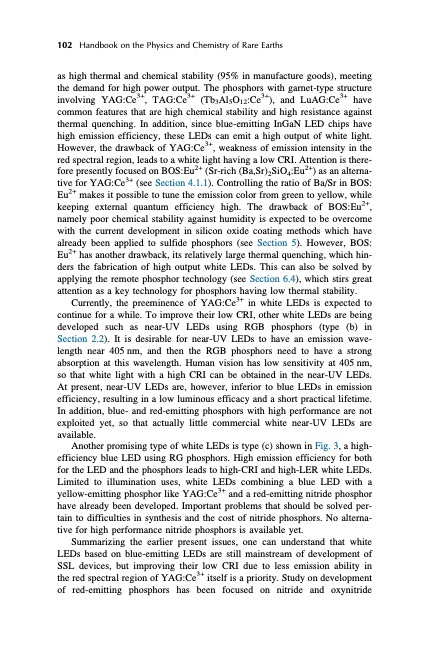
PDF Publication Title:
Text from PDF Page: 138
102 Handbook on the Physics and Chemistry of Rare Earths as high thermal and chemical stability (95% in manufacture goods), meeting the demand for high power output. The phosphors with garnet-type structure involving YAG:Ce3+, TAG:Ce3+ (Tb3Al5O12:Ce3+), and LuAG:Ce3+ have common features that are high chemical stability and high resistance against thermal quenching. In addition, since blue-emitting InGaN LED chips have high emission efficiency, these LEDs can emit a high output of white light. However, the drawback of YAG:Ce3+, weakness of emission intensity in the red spectral region, leads to a white light having a low CRI. Attention is there- fore presently focused on BOS:Eu2+ (Sr-rich (Ba,Sr)2SiO4:Eu2+) as an alterna- tive for YAG:Ce3+ (see Section 4.1.1). Controlling the ratio of Ba/Sr in BOS: Eu2+ makes it possible to tune the emission color from green to yellow, while keeping external quantum efficiency high. The drawback of BOS:Eu2+, namely poor chemical stability against humidity is expected to be overcome with the current development in silicon oxide coating methods which have already been applied to sulfide phosphors (see Section 5). However, BOS: Eu2+ has another drawback, its relatively large thermal quenching, which hin- ders the fabrication of high output white LEDs. This can also be solved by applying the remote phosphor technology (see Section 6.4), which stirs great attention as a key technology for phosphors having low thermal stability. Currently, the preeminence of YAG:Ce3+ in white LEDs is expected to continue for a while. To improve their low CRI, other white LEDs are being developed such as near-UV LEDs using RGB phosphors (type (b) in Section 2.2). It is desirable for near-UV LEDs to have an emission wave- length near 405 nm, and then the RGB phosphors need to have a strong absorption at this wavelength. Human vision has low sensitivity at 405 nm, so that white light with a high CRI can be obtained in the near-UV LEDs. At present, near-UV LEDs are, however, inferior to blue LEDs in emission efficiency, resulting in a low luminous efficacy and a short practical lifetime. In addition, blue- and red-emitting phosphors with high performance are not exploited yet, so that actually little commercial white near-UV LEDs are available. Another promising type of white LEDs is type (c) shown in Fig. 3, a high- efficiency blue LED using RG phosphors. High emission efficiency for both for the LED and the phosphors leads to high-CRI and high-LER white LEDs. Limited to illumination uses, white LEDs combining a blue LED with a yellow-emitting phosphor like YAG:Ce3+ and a red-emitting nitride phosphor have already been developed. Important problems that should be solved per- tain to difficulties in synthesis and the cost of nitride phosphors. No alterna- tive for high performance nitride phosphors is available yet. Summarizing the earlier present issues, one can understand that white LEDs based on blue-emitting LEDs are still mainstream of development of SSL devices, but improving their low CRI due to less emission ability in the red spectral region of YAG:Ce3+ itself is a priority. Study on development of red-emitting phosphors has been focused on nitride and oxynitridePDF Image | HANDBOOK ON THE PHYSICS AND CHEMISTRY OF RARE EARTHS

PDF Search Title:
HANDBOOK ON THE PHYSICS AND CHEMISTRY OF RARE EARTHSOriginal File Name Searched:
Chemistry-Rare-Earths-49.pdfDIY PDF Search: Google It | Yahoo | Bing
Sulfur Deposition on Carbon Nanofibers using Supercritical CO2 Sulfur Deposition on Carbon Nanofibers using Supercritical CO2. Gamma sulfur also known as mother of pearl sulfur and nacreous sulfur... More Info
CO2 Organic Rankine Cycle Experimenter Platform The supercritical CO2 phase change system is both a heat pump and organic rankine cycle which can be used for those purposes and as a supercritical extractor for advanced subcritical and supercritical extraction technology. Uses include producing nanoparticles, precious metal CO2 extraction, lithium battery recycling, and other applications... More Info
| CONTACT TEL: 608-238-6001 Email: greg@infinityturbine.com | RSS | AMP |